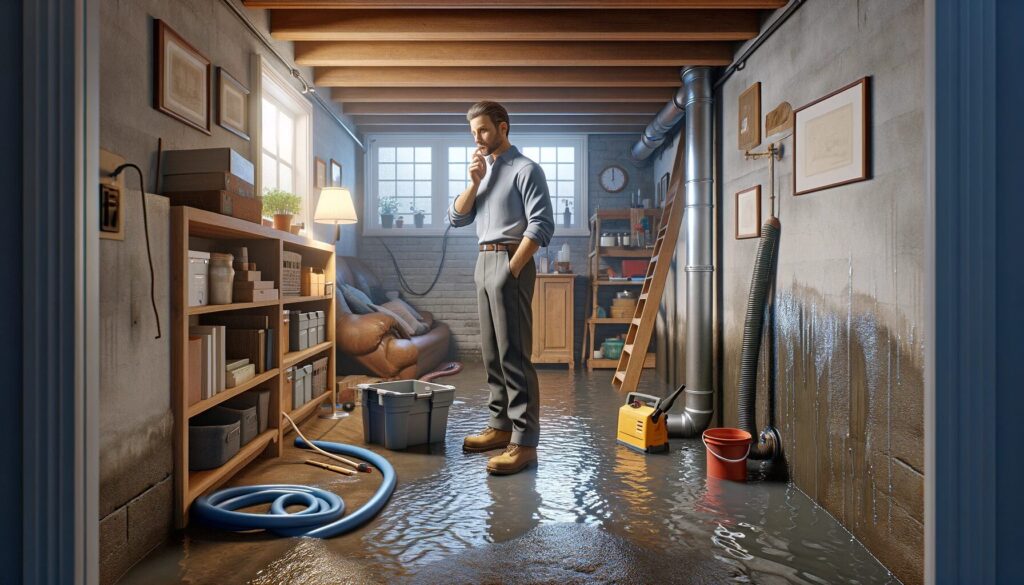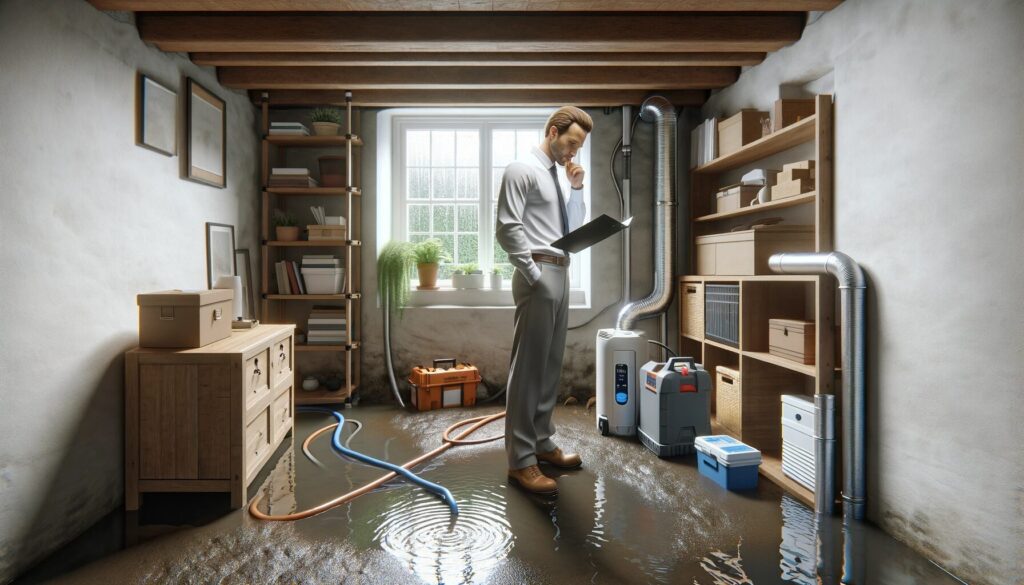In the world of home construction and renovation, addressing a wet basement is a challenge that stands out for its urgency and complexity. This issue is not just a nuisance but a critical problem that can affect the very foundation of your home. Whether you’re a DIY enthusiast or a seasoned construction professional, recognizing and tackling these issues effectively is essential for the longevity and safety of your home.

- Hydrostatic Pressure: Imagine the soil around your home saturated with water, exerting relentless pressure against basement walls and floors. This pressure can lead to water seepage, especially if there are any vulnerabilities in your foundation.
- Capillary Action: It’s a physics lesson in your basement. Moisture from the ground can be wicked up through porous building materials, leading to dampness even without visible water intrusion.
- Condensation: It’s a stealthy culprit. Warm, humid air condenses on cooler basement surfaces, creating moisture problems that can be as damaging as leaks.
Ignoring a wet basement can have serious repercussions. It’s not just about a temporary inconvenience, it’s about preventing long-term issues like mold growth and structural damage, which can be both costly and hazardous to your health.
Understanding Wet Basements
How and Why Basements Become Wet:
- Beyond Rain and Floods: Groundwater fluctuations and snowmelt are less obvious but equally significant causes of wet basements.
- The House ‘Breathing’ Effect: Your home’s air exchange can impact basement moisture levels, with poor ventilation exacerbating the issue.
Spotting a Wet Basement:
- The Nose Knows: A musty odor is often the first sign of a moisture problem.
- Look for Clues: Water stains, efflorescence, and mold are visual indicators that your basement is suffering from moisture issues.
Long-term Effects of Ignoring Wet Basement Issues:
- Mold and Mildew: Beyond the unpleasant smell, these can pose serious health risks, particularly to respiratory health.
- Structural Integrity at Risk: Persistent moisture can weaken foundations and structural elements, potentially leading to costly and extensive repairs.

Causes of Wet Basements
External Factors:
- Weather and Environment: Heavy rainfall, flooding, and inadequate yard drainage can lead to significant water intrusion.
- Improper Landscaping: Ground sloping towards your house can direct water straight to your basement.
Internal Factors:
- Plumbing Issues: Hidden leaks in walls can slowly contribute to moisture buildup.
- Condensation on Pipes: Pipes that “sweat” in humid conditions can add to the overall moisture level in your basement.
- Indoor Humidity: High humidity levels within your home can lead to condensation, particularly in cooler basements.
Structural Issues:
- Foundation Cracks: Small cracks can allow moisture to seep into your basement.
- Aging Waterproofing: Over time, waterproofing methods can deteriorate and become less effective.
- Window and Door Seals: Compromised seals can be entry points for moisture.
Preventive Measures
In the craft of home renovation, I’ve learned that prevention is key, especially when it comes to basements. It’s not just about fixing issues, it’s about stopping them before they start.
- Seasonal Check-Ups: Twice a year, do a thorough walk-around of your home. Look for any changes in the landscape or foundation that could spell trouble. It’s a small effort that can prevent big problems.
- Gutters and Downspouts: Keep them clear of debris. It’s a simple job that can save you from complex issues. Make sure they’re directing water away from your home’s foundation.
Landscaping and Exterior Drainage:
- Grade Your Landscape: Ensure the ground slopes away from your foundation. This natural runoff is your first line of defense against basement moisture.
- French drains: If you’re seeing consistent moisture issues, a French drain can be a game-changer. It’s a weekend project that pays off in spades.
Ventilation and Dehumidification:
- Air Flow is Crucial: Basements need to breathe to avoid moisture buildup. Proper cross-ventilation can make a significant difference.
- Dehumidifiers: Especially in humid climates, a dehumidifier can be a vital tool in keeping your basement dry and healthy.

DIY Solutions for Wet Basements
Dealing with a wet basement can be daunting, but with the right approach, it’s manageable.
- Find the Source: Trace the water to its origin. It could be as simple as a leaky pipe or a crack in the wall.
- Seal the Deal: For small cracks, hydraulic cement or a waterproof masonry product can be effective. Remember, preparation is key – clean and dry the area first.
Sealing Basement Walls and Floors:
- Preparation: Start with a clean, dry surface. A little effort in preparation goes a long way in ensuring the effectiveness of your sealant.
- Choosing Sealants: Pick a product designed for basements – they’re formulated to handle the tough conditions down there.
Improving Internal Drainage and Sump Pump Installation:
- Interior Drainage Systems: Installing an interior weeping tile system can be a big project, but it’s a long-term solution to direct water away from your basement.
- Sump Pump Know-How: A well-installed sump pump is a basement’s best friend. Ensure it directs water away from your foundation and consider a backup power source.
Professional Wet Basement Repair
Sometimes, the issue is beyond the DIY scope, and that’s when professionals come into play.
- Recognizing the Big Issues: If you’re facing persistent or unclear sources of water intrusion, a professional’s insight is invaluable.
- Look for Structural Signs: Significant cracks or bowing in basement walls are a clear signal that professional help is needed.
Professional Solutions:
- Beyond Surface Treatments: Professionals offer solutions like full interior/exterior waterproofing and foundation repair that go deeper than what a DIY approach can achieve.
- Foundation Matters: Sometimes the problem lies with the foundation itself, and that’s where professional repair can be a worthwhile investment.
Choosing the Right Contractor:
- Word of Mouth: Personal referrals are often the best way to find a reliable contractor.
- Credentials and Reviews: Ensure they have the necessary licenses and insurance, and check their track record.
- Comparative Quotes: Get several quotes to understand the market rate and the scope of services offered.
Innovative Products and Materials
In the evolving landscape of home renovation, we’ve witnessed a remarkable transformation in the tools and materials available for waterproofing. These innovations aren’t just about keeping up with the Joneses, they’re about offering long-term, effective solutions.
- Polyurethane Liquid Membranes: Think of it as a raincoat for your basement. This material goes on liquid but dries into a waterproof, flexible barrier that moves with your house, accommodating shifts and settling.
- Bentonite Panels: These panels, made from natural clay, swell when they come into contact with water, creating a solid barrier against moisture. They’re particularly effective in new constructions or major renovations.
Latest Technologies in Basement Drainage and Sealing:
- Drainage Mats: These mats create a pathway for water, helping direct it to your drainage system and away from your basement walls. It’s an efficient way to manage water flow and protect your foundation.
- Sealant and Insulation Boards: These innovative boards do double duty by providing both insulation and waterproofing, streamlining your renovation process and adding efficiency.
Eco-friendly and Cost-effective Options:
- Recycled Rubber Waterproofing: A sustainable choice, these products utilize recycled tires, turning waste into a durable, waterproofing material.
- Sustainable Drainage Systems (SuDS): These systems are designed to replicate natural water absorption and runoff processes, reducing the impact on your basement and the environment.
Case Studies: Successful Wet Basement Repairs
Over the years, I’ve encountered various challenges in basement renovation, each requiring a tailored approach.
- The Old Farmhouse: Battling persistent leaks, we installed exterior French drains and applied interior sealants. The transformation was remarkable, turning a perpetually damp space into a dry and comfortable area.
- Suburban Split-level: Faced with a high water table, we implemented a sump pump system coupled with interior weeping tiles, effectively mitigating the water problem.
- City Rowhouse: The homeowner addressed minor water intrusion with a well-applied sealant and a strategically placed dehumidifier, proving that sometimes a simple approach is all you need.
- The Hillside Home: This project required expert intervention. We tackled it with an exterior waterproofing membrane and regraded the surrounding landscape, providing a comprehensive solution to their water issues.
FAQ Section
Early signs include damp patches on walls or floors, a musty smell, and visible efflorescence – a white, powdery mineral deposit often seen on damp surfaces. These symptoms suggest moisture problems that shouldn’t be overlooked.
For minor issues, DIY approaches can be effective. They work well for addressing small leaks or reducing condensation. However, for more serious or persistent problems, professional assessment and intervention are recommended.
Regular inspection is key. I recommend checking your basement for moisture at least twice a year, typically in the spring and fall. This routine helps catch potential issues early.
Neglecting a wet basement can lead to more serious issues. These include mold growth, which poses health risks, and structural damage, which can compromise the integrity of your home.
For small leaks, products like hydraulic cement or waterproof mastic can offer a temporary solution. However, it’s important to view these as stopgap measures while you plan for a more comprehensive, long-term fix.
